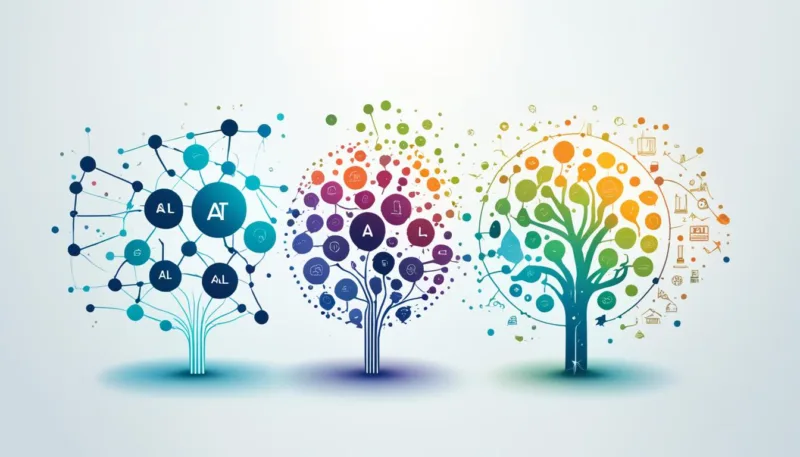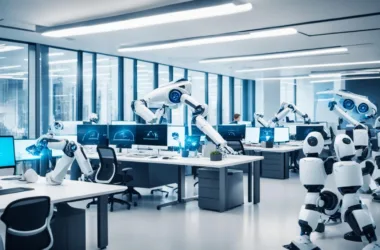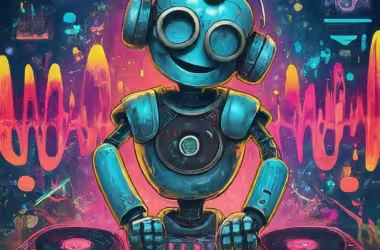Understanding the diverse artificial intelligence categories is key. These types of AI are based on their abilities and how they work. They include Narrow AI, General AI, and Super AI, plus Reactive Machines, Limited Memory AI, Theory of Mind AI, and Self-Aware AI.
Narrow AI is leading the way today. It benefits from deep learning and artificial neural networks. It’s at the heart of many modern applications and may pave the way for General AI and Super AI.
Key Takeaways
- Artificial Intelligence can be categorized based on capabilities and functionalities.
- Narrow AI is currently the most prevalent type, powered by deep learning and neural networks.
- Future advancements may lead to the development of General AI and Super AI.
- Functionalities-based AI includes Reactive Machines, Limited Memory AI, Theory of Mind AI, and Self-Aware AI.
- The understanding of AI types helps navigate the complexities of AI technology and its applications.
Introduction to Artificial Intelligence
Artificial Intelligence, or AI, has become a key part of tech talks today. It started with John McCarthy in 1956. Since then, AI has grown a lot. It now includes smart machines that do jobs we usually think need a human touch.
Definition of Artificial Intelligence
AI means computer systems that do tasks needing human smarts. These tasks are like seeing patterns, learning, understanding languages, and making choices. Thanks to AI, we now have intelligent machines. They get better and faster at these tasks.
The Evolution of AI
The AI story has many important moments. At first, AI systems were simple and needed a lot of help from humans. But as time went by, things like deep learning and neural networks came along. These changes brought us closer to systems that learn on their own.
Now, AI keeps reaching new heights. It’s creating systems that act more and more like humans.
Narrow AI (Artificial Narrow Intelligence)
Narrow AI is also called Weak AI. It is designed to handle specific tasks within set parameters. It’s different from more advanced AI because it focuses on singular tasks. This makes Narrow AI very important in today’s tech scene.
Characteristics of Narrow AI
Narrow AI is special because it works in a limited area. These systems don’t understand like humans or think on their own. They are made to be really good at certain things, like understanding speech or analyzing data. They learn from lots of data to give precise results in their area.
Examples of Narrow AI
There are famous examples of Narrow AI around us. Siri by Apple and Alexa by Amazon are made for tasks such as setting reminders or managing smart homes. IBM’s Watson is another example. It helps in making decisions in healthcare and business by processing lots of data.
Applications and Limitations
Narrow AI is used in many fields like customer support, finance, and healthcare. Chatbots, for example, make customer service better by giving fast answers and solutions. But, Narrow AI can only do what it’s programmed to do. It can’t tackle tasks outside its set skills, which shows its limits compared to more versatile AI.
These points highlight the difference between Weak AI and more complex AI systems. They show the specific, yet vital, role of Narrow AI in our digital world.
General AI (Artificial General Intelligence)
Artificial General Intelligence (AGI), or Strong AI, is a kind of AI with great cognitive skills. It’s different from Narrow AI, which can only do specific tasks. AGI could potentially think and learn like humans, across many activities.
Defining General AI
General AI can perform any mental task a person can do. It seeks to combine many cognitive skills. These include problem-solving and learning from experience. It’s this ambition that makes AGI different from current AI, which has set functions.
Theoretical Capabilities of General AI
AGI could have the skill to reason, make plans, and talk in humans’ languages. It would learn from various situations and use its knowledge to tackle new problems. This shows how Strong AI could change many industries.
Future Prospects
The future of AGI is thrilling. It could reshape industries by giving machines human-like thinking abilities. But, reaching AGI faces both ethical and technical challenges. Still, the goal of creating smart systems as clever as people excites many.
Super AI (Artificial Super Intelligence)
ASI is at the top of AI developments. It is thought to beat human skills in every way. This includes solving problems, making decisions, learning, and reasoning. The idea of AI surpassing human intelligence is about an AI that feels, wants, and knows itself.
Today, we have Narrow AI and General AI for specific and broad tasks. But, artificial superintelligence would top them in thinking. It could do complex analyses and change on its own. This goes beyond our current idea of intelligence.
Thinking about AI surpassing human intelligence brings up many thoughts. It could greatly help in science, medicine, and tech. Yet, it also brings up big questions about ethics. What happens when these AIs start having their own needs and thoughts?
At this point, artificial superintelligence is just a theory. But, it’s a hot topic for AI researchers. As we get closer to making this big jump, figuring out how to do it safely and ethically is key.
Reactive Machines
Reactive Machine AIs focus on specific tasks, unable to remember or learn from the past. They look at data right now and respond based on that. This makes them quick and precise in their tasks.
How Reactive Machines Work
These AIs analyze data without past memories. They act based on what’s happening at the moment. By doing this, they can give quick, accurate reactions to situations without being swayed by history.
Examples of Reactive Machines
IBM Deep Blue is a famous Reactive Machine AI. It beat chess champion Garry Kasparov in 1997.
Deep Blue could think through many chess moves ahead. It didn’t use memories of past games. The Netflix Recommendation Engine is another good example. It suggests shows and movies by analyzing current data on user likes and activities. It offers personalized recommendations without using past choices.
Limited Memory AI
Limited Memory AI marks a big step in making machines smarter. It uses past data to make better choices now. Unlike simple machines that only look at current data, this AI learns from history. This learning makes it more accurate and useful.
Understanding Limited Memory AI
Limited Memory AI holds on to temporary data to improve its learning. It’s behind many advanced systems today, like self-driving cars. These cars collect data through sensors to improve driving, ensuring safety and efficiency.
Current Applications in Technology
Self-driving cars are a major use of Limited Memory AI. They process lots of data from sensors to drive and avoid obstacles. Digital assistants like Google Assistant and Amazon Alexa are also examples. They get better at understanding us by learning from our commands.
Future Potential
The future of Limited Memory AI looks promising as machine learning grows. It could change many fields, like delivery and healthcare. Imagine drones that change their path to avoid delays. As these AI algorithms get better, we’ll see more innovation and efficiency.
Theory of Mind AI
Artificial intelligence is reaching new heights with the emerging Theory of Mind in technology. This new AI aims to grasp and simulate human emotions and thoughts. It moves beyond just processing data.
Emotional intelligence AI aims to create real connections with users. It’s still mostly a theory, but its uses could be vast. Imagine having virtual friends, better customer service, and new ways to help in therapy.
By learning how humans feel, Theory of Mind AI could vastly improve how digital services cater to us.
To make this AI, we need complex models that figure out emotions from context. This is key to making smarter, more natural interactions with technology. It may change how we interact with machines forever.
In summary, emotional intelligence AI and Theory of Mind in technology show a bright future. They point towards an era where AI can truly get and respond to human emotions.
Self-Aware AI
The idea of self-aware AI is exciting. It means AIs could know they exist. This could change how we talk to machines, making them understand and care about our feelings.
Concept of Self-Aware AI
Self-aware AI would be like machines knowing themselves. They would get their own state, the world around them, and why they interact. This kind of AI would do more than just sort data. It would make choices based on how it sees itself. Now, we’re working on Emotion AI. It’s a step to making robots know and react to how we feel.
Challenging Human Emotions and Consciousness
Putting consciousness in AI and making it get our feelings is hard. We need smart ways to teach AI about emotions and self-awareness. Scientists want robots to understand us better. This means they have to learn from experiences and show emotional awareness.
As we move towards this goal, we face big questions. Making machines that can feel sparks hope and worry. If we succeed, we’ll see a new kind of smart machine. This change would take AI to places we’ve never seen before.
Emerging Trends in AI Applications
AI innovation is growing fast. It’s changing everything from healthcare to transportation. AI is reshaping how technology and industries work.
AI in Healthcare
In healthcare, AI’s impact is huge. It makes diagnosing precise, administrative work smoother, and treatments more personal. Doctors use AI to predict diseases early. This leads to better health results and more efficient operations.
AI in Transportation
AI is also transforming transportation. It’s behind the push for self-driving cars. These vehicles use advanced algorithms and learn on their own. They aim to make roads safer and commuting easier. AI also makes traffic flow better, cutting down on jams and shortening trips.
AI in Robotics
Robotics is speeding up thanks to AI. Robots powered by AI do everything from factory work to complex surgeries. They boost productivity, work with precision, and make fewer mistakes even in tricky tasks.
AI in Education
The world of education benefits from AI too. AI tools offer custom learning experiences. They identify what students are good at and where they need help. Educational content becomes more suited to each learner. AI also powers online learning sites that give instant feedback and keep students engaged.
AI keeps getting better, touching more areas of life and work. It’s proving to be a game-changer across different fields. As AI keeps growing, its influence will only expand, bringing more efficiency, accuracy, and possibilities.
Conclusion
The journey of artificial intelligence (AI) has truly changed the game. It has reshaped how we see technology and its future. From the start, AI’s growth has been impressive. Now, narrow AI is changing our daily lives through things like smart helpers and smart suggestions. And this is just the beginning.
Looking ahead, the idea of General AI and Super AI is thrilling. They could change what intelligent systems can do. It’s not just about smarter machines. It’s about giving them the ability to learn and maybe even feel like we do. These changes could deeply affect society, touching everything from health to learning.
Thinking about AI’s role in our future makes its impact clear. As AI keeps getting better, it won’t just lead to new inventions. It will start a new phase of working together with technology. We’re at the edge of an amazing future. AI’s growth might soon change how we think about smarts itself.






